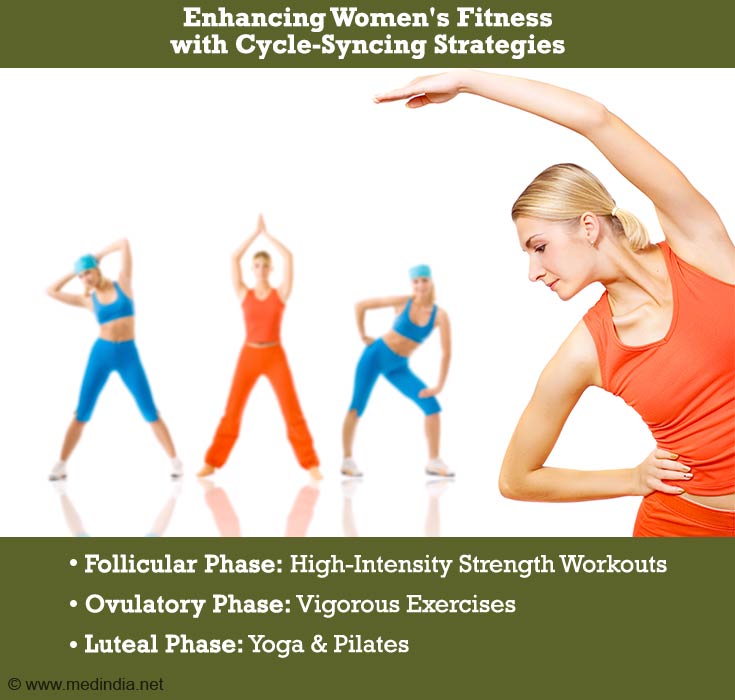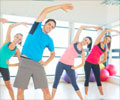- Health Benefits of Exercise - (https://pubmed.ncbi.nlm.nih.gov/28507196/)
- Physical activity for health - (https://www.ncbi.nlm.nih.gov/pmc/articles/PMC9710390/)
- The Effects of Menstrual Cycle Phase on Exercise Performance in Eumenorrheic Women: A Systematic Review and Meta-Analysis - (https://pubmed.ncbi.nlm.nih.gov/32661839/)
- Physical activity guidelines for older adults - (https://pubmed.ncbi.nlm.nih.gov/20052963/)
- Exercise for arthritis - (https://pubmed.ncbi.nlm.nih.gov/8149442/)
- The Effectiveness of Physical Exercise on Bone Density in Osteoporotic Patients - (https://www.ncbi.nlm.nih.gov/pmc/articles/PMC6323511/)
- Comparative effectiveness of aerobic, resistance, and combined training on cardiovascular disease risk factors: A randomized controlled trial - (https://pubmed.ncbi.nlm.nih.gov/30615666/)
- Exercise prescription for persons with spinal cord injury: a review of physiological considerations and evidence-based guidelines - (https://pubmed.ncbi.nlm.nih.gov/37816259/)
- Exercise and Quality of Life in Women with Menopausal Symptoms: A Systematic Review and Meta-Analysis of Randomized Controlled Trials - (https://pubmed.ncbi.nlm.nih.gov/32993147/)
About
Embarking on a fitness journey is not a one-size-fits-all endeavor. As we traverse through the different phases of life, our bodies and health needs evolve. Fitness goals should be adaptable, allowing for flexibility in workout routines. Tailoring a fitness routine to align with these distinct life stages ensures a sustainable and effective approach.
Importance of Fitness
Maintaining a consistent fitness routine is a cornerstone of overall well-being, transcending age and life stages. Regardless of whether you are a fitness enthusiast or a newcomer, understanding the pivotal role of regular exercise is essential. A well-designed fitness program not only enhances physical health but also contributes to mental and emotional well-being(1✔ ✔Trusted Source
Health Benefits of Exercise
Go to source).
As we progress through different phases of life, the benefits of a fitness routine become even more pronounced. Regular physical activity has been linked to improved cardiovascular health, reduced risk of chronic diseases, enhanced cognitive function, and better mood regulation(2✔ ✔Trusted Source
Physical activity for health
Go to source). It forms the foundation for a resilient and agile body, laying the groundwork for a healthier and more fulfilling life.
Beginning the Fitness Journey
For fitness novices, starting with a beginner exercise routine is crucial. Begin with low-impact exercises to build a foundation and gradually progress to more intense workouts. Establishing consistency is key; even a short morning workout can yield significant benefits over time. Understanding the three basic stages of a fitness program is vital:
- Initiation: Begin with a workout schedule that accommodates your fitness level. Focus on workout effectiveness rather than intensity.
- Progression: As you advance, tailor your fitness program to meet evolving goals. Incorporate cycle-syncing workouts for women, adapting to hormonal fluctuations.
- Maintenance: Stay fit forever by finding a workout routine that aligns with your lifestyle and preferences. Prioritize exercise consistency over intensity, allowing for sustainable fitness goals.
Special Workouts for Women
Tailoring workout strategies for women involves a nuanced understanding of the impact of various life stages. From pregnancy to menopause, adapting exercise routines during periods or addressing hormonal changes is crucial for maintaining overall well-being.
Recognizing the unique challenges women face, cycle-syncing workouts can prove beneficial by optimizing exercise effectiveness and catering to specific physical and emotional needs during different phases of the menstrual cycle. This approach involves adjusting workout intensity and types of exercises based on the hormonal fluctuations that occur during the menstrual cycle, aiming to align physical activity with the body's natural rhythm(3✔ ✔Trusted Source
The Effects of Menstrual Cycle Phase on Exercise Performance in Eumenorrheic Women: A Systematic Review and Meta-Analysis
Go to source).

Understanding the menstrual cycle's distinct phases - follicular, ovulatory, and luteal - allows women to tailor their workouts accordingly. During the follicular phase, when estrogen levels are on the rise, incorporating high-intensity interval training and strength workouts can capitalize on increased energy levels. The ovulatory phase, marked by peak estrogen, supports more vigorous exercises, while the luteal phase benefits from activities like yoga and Pilates, focusing on flexibility and stress reduction.
By syncing workouts with the menstrual cycle, women can optimize their fitness routines, enhance overall well-being, and promote a positive relationship with exercise throughout different stages of life. Consulting with healthcare professionals and fitness experts ensures that cycle-syncing approaches are personalized and align with individual health needs.
Fitness Tips for Age-Related Concerns
Exercise remains a cornerstone of healthy aging, offering a myriad of benefits for seniors. Tailoring workout routines to accommodate individual fitness levels and health conditions is paramount. Low-impact activities like walking, swimming, and gentle yoga contribute to cardiovascular health and flexibility without undue strain on joints.
For seniors with lower bone density, opting for lower-impact exercises reduces the risk of fractures. Strength training with light weights aids in maintaining muscle mass and bone density, crucial for preventing age-related issues such as osteoporosis. Incorporating flexibility and balance exercises becomes essential to reduce the risk of falls, promoting stability and coordination(4✔ ✔Trusted Source
Physical activity guidelines for older adults
Go to source).
Regular physical activity not only enhances overall well-being but also fosters a sense of independence and vitality in the senior years. Always consult with a healthcare professional before embarking on a new exercise regimen to ensure safety and suitability for individual health circumstances.
Managing Chronic Conditions with Exercise
Fitness plays a pivotal role in managing various health conditions. Navigating exercise with specific health conditions demands a nuanced approach. For those grappling with arthritis, low-impact strengthening activities, aerobic conditioning and flexibility exercises can alleviate discomfort(5✔ ✔Trusted Source
Exercise for arthritis
Go to source). Opting for aquatic exercises minimizes joint stress. Individuals with osteoporosis benefit from weight-bearing exercises to strengthen bones, accompanied by safety precautions to mitigate fracture risks(6✔ ✔Trusted Source
The Effectiveness of Physical Exercise on Bone Density in Osteoporotic Patients
Go to source). Managing diabetes through exercise involves consistent routines that regulate blood sugar levels, contributing to overall well-being. Cardiovascular disease calls for a blend of aerobic exercises and strength training to support heart health(7✔ ✔Trusted Source
Comparative effectiveness of aerobic, resistance, and combined training on cardiovascular disease risk factors: A randomized controlled trial
Go to source).
In instances like spinal cord injury or cancer treatment, customized exercise regimens are imperative. Adapting workouts after spinal cord injury requires a focus on mobility and strengthening surrounding muscles. Modified forms of exercise encompass arm cycle ergometry, hybrid arm-leg cycling, and recumbent elliptical equipment.
Engaging in body weight-supported treadmill training and various rehabilitation methods could enhance certain facets of health and fitness in individuals with spinal cord injuries, provided the exercises are conducted at an adequate intensity level(8✔ ✔Trusted Source
Exercise prescription for persons with spinal cord injury: a review of physiological considerations and evidence-based guidelines
Go to source).
During cancer treatment, tailored approaches prioritize gentler exercises, emphasizing safety precautions to accommodate energy levels and potential side effects. This individualized approach ensures that exercise remains a supportive element in managing health conditions, promoting holistic well-being.
Adapting Workouts for Menopause
Menopause is a transformative phase marked by fluctuating estrogen levels, influencing various physiological aspects, including heart rate and weight. To navigate this transitional period effectively, it becomes imperative to customize workout routines that cater to managing prevalent symptoms such as hot flashes and mood swings. In this context, prioritizing low-impact exercises emerges as a key strategy, offering a gentle yet effective approach to fitness.
Embracing low-impact exercises during menopause not only addresses the physiological changes but also contributes to maintaining toned musculature. Activities like swimming, brisk walking, and cycling provide cardiovascular benefits without subjecting the joints to excessive stress. Incorporating strength training with lighter weights further supports muscle tone and bone density.
Women experiencing menopausal symptoms and urinary issues can opt for yoga and pelvic floor muscle training (PFMT), respectively(9✔ ✔Trusted Source
Exercise and Quality of Life in Women with Menopausal Symptoms: A Systematic Review and Meta-Analysis of Randomized Controlled Trials
Go to source). This tailored approach not only aids in managing the challenges associated with menopause but also promotes overall well-being, ensuring women navigate this phase with physical resilience and vitality.
Safety Precautions While Exercising
Regardless of life stage, safety remains paramount. Here are some safety tips for all ages:
- Always consult with a healthcare professional before starting a new exercise routine, especially if you have pre-existing health conditions.
- Warm up adequately before engaging in more intense exercises to prepare your muscles and joints.
- Use proper form and technique during exercises to prevent injuries and maximize effectiveness.
- Wear appropriate workout attire and supportive footwear to ensure comfort and minimize the risk of accidents.
- Stay hydrated by drinking water before, during, and after your workout to prevent dehydration.
- Listen to your body and modify exercises or stop if you experience pain, dizziness, or any unusual symptoms.
- Incorporate a cool-down routine at the end of your workout to gradually bring your heart rate back to normal and reduce muscle soreness.
- Pay attention to your surroundings, especially if exercising outdoors, to avoid tripping or colliding with obstacles.
- If you have specific health concerns or conditions, consider working with a certified fitness professional to design a safe and personalized exercise plan.
- Gradually progress the intensity and duration of your workouts to allow your body to adapt and reduce the risk of overuse injuries.
Adapting your fitness routine to every phase of life ensures that you not only meet your current health needs but also invest in a resilient and vibrant future. From the initiation of a workout program to its progression and maintenance, each stage requires thoughtful consideration. By understanding the nuances of fitness through life stages, incorporating age-specific strategies, and prioritizing safety precautions, you pave the way for a holistic and sustainable approach to well-being. Fitness is not a destination; it's a lifelong journey, and adapting your routine ensures that you stay on the path to a healthier and happier you.









